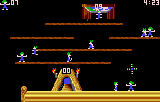Computer and video game genres
|
|
This is listing of computer and video game genres with a brief description and examples from each genre. This list is by no means complete or comprehensive. As with nearly all varieties of genre classification, the matter of any individual computer or video game's specific genre is open to personal interpretation.
Within game studies there is a lack of consensus in reaching accepted formal definitions for game genres, some being more popular than others. For example, some schemas are largely semiotic, while others rely more strongly on configurative patterns of interface and mechanics.
Many of these categories overlap due to the subjective nature of many genres. For example, the Legend of Zelda series has elements of action, adventure and role-playing. This overlapping is further pronounced as more games are being produced and styled as hybrids, blending elements characteristic to one or more popular genres (for example, action-RPGs like Diablo, Vagrant Story, and Baldur's Gate: Dark Alliance).
| Contents [hide] |
|
1.1 Fighting 1.5 Role-playing |
Major genres
Fighting
Street_Fighter_2.png
Fighting or beat 'em up games emphasize one-on-one combat between two players, one whom may be computer controlled. These games usually focus on martial arts, which are usually dramatic and physically impossible, and other forms of unarmed combat. Some of these games may also employ handheld weapons such as swords, or ranged attacks such as chi-based energy blasts.
This genre arose in the mid-1980s and became a phenomenon with the release of Street Fighter II; the genre is still popular today.
Notable series of games include King of Fighters, Mortal Kombat, Street Fighter, Soul Edge and Soul Calibur, Tekken, and Virtua Fighter.
First-person shooter

First-person shooters (FPS) emphasize shooting and combat from a specific perspective. Most FPSs place the player behind a gun or other weapon with the player's "hand" holding the weapon. This perpective is meant to give the player the feeling of "being there." Most FPSs are very fast-paced and require quick reflexes.
To be an effective game, an FPS needs to be both fast and 3-dimensional, which put them out of the reach of most consumer hardware until the early 1990s. Doom was the "breakout" game of the genre; it used a number of clever techniques to make the game fast enough to run on average machines.
Some of today's most popular FPS series are Doom, Half-Life, Halo, Quake, and Unreal.
MMOGs and MMORPGs

Massively-multiplayer online games and massively-multiplayer online role-playing games are subscription-based virtual worlds in which potentially thousands of players may interact together over the Internet. MMORPGs emerged in the mid to late 1990s as a commercial, graphical variant of text-based MUDs, which had existed since around 1979. The massively multiplayer concept was quickly combined with other genres.
Fantasy MMORPGs are the most popular type of MMOG. Ultima Online, EverQuest, Final Fantasy XI, Lineage, and World of Warcraft are some of the more popular MMORPGs.
Sci-Fi MMORPGS is a smaller type of MMOG, for example Anarchy Online and the popular space sci-fi game EVE Online.
Racing
Racing games are one of the most traditional of genres. They typically place the player in the driver's seat of a (usually high performance) vehicle and require the player to race against other drivers or sometimes just time. Emerging in the early 1980s, this genre is still very popular today and continues to push the envelope in terms of graphics and physics.
The usual racing genres are:
Racing simulators
(read main article)Real racing such as Forumla 1, Rally, Nascar or Touring car racing are simulated as realistically as possible.
Arcade racing
Sports cars, Muscle Cars or nowadays almost any vehicle race on a usually public road. Realism is sacrificed for more fun, as cars usually fight rather than comnpete. Races take place on highways/motorways, windy roads, or in cities; races may mean repeating a circuit over a number of laps, reaching a certain number of checkpoints, or other types of racing, like crashing, jumping or testing driving skills. Popular arcade racers are the Need for Speed series, OutRun and the Burnout series.
There are some subgenres, like:
Street racing
Imitating the import scene, the player can tune their (usually popular family) cars for racing on the streets. The most wide common known ones are the Need for Speed series, Midnight Club 3: DUB Edition, Street Racing Syndicate and Juiced
Kart racing
Simpler vehicle handling and various obstacles and pickups emphazise playability and amusement. The most sold one is the Mario Kart series.
Role-playing

Computer role-playing games (CRPGs or simply RPGs) often place the player in a fantasy or science fiction setting and drive the gameplay via a prominent storyline. Most of these games have the player acting in the role of a specific type of "adventurer" who specializes in a certain set of skills (such as combat, or casting magic spells). These various types of adventurer are called "classes" and players can normally control one or more of these characters.
Most of these games are similar to traditional role-playing games played with pencil and paper (notably D&D) except, in this case, the computer takes care of all the record keeping and nondeterministic elements such as die rolling. Since the emergence of affordable home computers coincided with the popularity of pencil and paper role-playing games, this genre was one of the first in video games and continues to be popular today.
Though nearly all of the early entries in the genre were turn-based games, modern CRPGs have introduced a real-time aspect, thanks largely to the success of Diablo and similarly designed games. Thus, the CRPG genre has followed the strategy game's trend of moving from turn-based to real-time combat.
Notable entries in the role-playing genre include Final Fantasy, Ultima, Diablo, Baldur's Gate, and Star Wars: Knights of the Old Republic.
Simulation

Simulations aim to simulate a specific real-life activity (such as flying an airplane) as realistically as practically possible, taking into account physics and other real-world limitations. Some require a great deal of reading before the game can even be attempted, while others include a simple tutorial. Unlike other genres of games, many simulations do not have a set goal that allows a player to win the game.
Some of these types of games, such as flight simulators, have a limited following, while others, such as The Sims (which generally simulates home-life and social interactions) have an enormous following, including those who don't consider themselves "gamers."
Flight simulators are a subgenre of simulation, as are wargames. Games such as The Sims, SimCity, SimAnt, and SimEarth are combinations of simulation and strategy.
Space Combat Sims are a subgenre that usually leans into strategy or action. Examples include Descent, Freespace, Freespace 2, Independence War and Wing Commander.
Sports

Sports games emulate the playing of traditional physical sports such as baseball, soccer, American football, boxing, golf, basketball, ice hockey, tennis, bowling, rugby, etc. Some emphasize actually playing the sport, while others emphasize the strategy behind the sport (such as Championship Manager). Others satirize the sport for comic effect (such as Arch Rivals). One of the best selling series in this genre is the Madden NFL series.
This genre emerged early in the history of video games and remains popular today.
Strategy
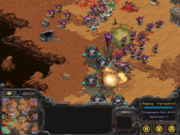
Strategy games focus on careful planning and skillful resource management in order to achieve victory, and are therefore classified as "thinking games". These games may be turn-based or realtime, but there are some that mix the two types of play (such as X-Com). This genre has had a consistent following since the mid-1980s.
The two main subgenres are turn-based and real-time games. Turn-based games were originally the common form of strategy game, the computers of the time being too slow for real-time interaction, and go back to Star Trek games played on teletypes. Early home computers were soon adopted for wargames, and the genre expanded from there.
The vast majority of strategy games could be called "war strategy games" as they have heavy focus on military combat. For real-time games the focus is generally on military battle tactics(e.g. reconnaissance, flanking, etc.), while turn-based games are more focused on strategy (i.e. looking at war from a General's perspective).
Examples of games in the real-time genre include Warcraft, StarCraft, Command and Conquer, and Total Annihilation. Additional noteworthy examples are Ground Control, Sudden Strike and Mech Commander, which focus on a set amounts of units, and do away with the resource gathering and unit production aspects of most RTS games.
Examples of turn-based games include Sid Meier's Civilization, the Heroes of Might and Magic series, and the Fire Emblem series.
Web based strategy games are a less popular variant where the player doesn't need any additional software installed at their computer because the games have web site interfaces. Such games often last for several months, before the round ends and the game restarts. Some of these games are extremely popular and have hundreds of thousands of players. Examples of web based strategy games are Planetarion, Dawn of Myth and Terra Incognita.
MMORTS is a extremely small subdivision, but has proven to have great potential. Games of this sub-genre include Shattered Galaxy, Mankind and the recently scraped in development Sovereign.
Third-person shooters
PSX_Tomb_Raider.png
Third-person shooters (TPS) employ a third person perspective for the player. This is normally just behind the game character, but it is sometimes an isometric perspective. Some shooters default to either a first- or third-person perspective but allow the player to choose between the two; others switch between the two at predetermined points in the game.
The Grand Theft Auto series falls into this genre, as do such games as Heretic II, Jet Force Gemini, Max_Payne, Mafia, Magic Carpet and Oni.
Notable genres
Adult
Adult video games, like adult movies or other media, are intended for an adult audience. There exists a wide variety of adult games, though many lack mainstream appeal and represent a niche category. The object of an adult game may differ from a mainstream video game or computer game, in that the reward can be a visual representation of nudity, partial nudity, or sexual activity rather than points, etc. Some games may focus on humor or drama rather than arousal, or simply have normal gameplay accompanied by nudity.
Educational
OregonTrailScreenshot.JPG
Educational games, as the name implies, attempt to teach the user using the game as a vehicle. Most of these types of games target young user from the ages of about three years to mid-teens; past the mid-teens, subjects become so complex (e.g. Calculus) that teaching via a game is impractical. Numerous subgenres exist, each for a different field (math games, typing games and so on).
Notable games in the genre include the Carmen Sandiego series, Mavis Beacon Teaches Typing, and the Oregon Trail series. Programming games like Robocode and Core War may also be put in the educational category. A somewhat less serious approach to the genre is typified by the typing tutor The Typing of the Dead.
Music
DDR(bag).jpg
Music games are typically arcade games that challenge the player to follow sequences of movement or develop specific rhythms. Some games require the player to tap out rhythms using a game controller or keyboard while others require the player to actually dance in sync to music. This genre arose in the late 1990s with the increasing popularity of rap music and the success of Dance Dance Revolution.
See also: audio game.
Party
Party games are video games developed specifically for multiplayer games between many players. Normally, party games have a variety of different types of mini-games that range between collecting more of a certain item than other players or having the fastest time at something. Versus multiplayer games are not generally considered to be party games. Popular party games include the Mario Party series and Fusion Frenzy.
Platform

Platform games, also called platformers, are games in which downward gravity restricts the player to travelling on horizontal surfaces, which are referred to as platforms.
This is one of the earliest genres of computer games, and was once very popular and well-supported, but has declined with the increasing popularity of 3D graphics. Traditionally, platform games were 2D, viewing the environment from a side-on, 'cutaway' perspective. This could be done easily with sprites and was simple for early computers to handle. 3D computer graphics have removed the necessity for this restricted view, and can create platform worlds in full 3D. However, this loses the simplicity of control and gameplay of the 2D games. Nonetheless, 3D platformers are not uncommon.
Traditional elements of platform games include running, jumping, and climbing ladders and ledges. Fighting and shooting are also frequent elements.
Notable platform games and series include Donkey Kong, Super Mario Bros., Metroid, Lode Runner, Commander Keen, Sonic the Hedgehog, Spyro the Dragon and Crash Bandicoot.
Puzzle
Puzzle games require the player to solve logic puzzles or even navigate complex locations such as mazes. This genre frequently crosses over with adventure and educational games. Some arcade games, in particular Tetris-variants, are often labeled puzzle games, despite the fact that gameplay depends on hand/eye coordination and quick reflexes, rather than thought and logic.
Famous puzzle games include Lemmings, Minesweeper, and Boulder Dash; see list of computer puzzle games for more.
Shoot 'em up

Shoot 'em ups, also known as 'shmups' or 'shooters', place emphasis on shooting, and usually simplify other gameplay aspects of in deference to this. Several of the earliest arcade games (such as Space Invaders) could be classed as shoot 'em ups, although in practice they are usually not.
The games that typify the shoot 'em up genre are scrolling shooters - shoot 'em ups that are traditionally played on a long, 2D, scrolling playing area. Scrolling shooters are generally classified by their direction of scroll: the most common are horizontal (side view) and vertical (top view) shooters. Two examples are R-Type and Raiden respectively.
There are also fixed shooters, which take place on a single screen; for example, Robotron: 2084.
The shoot 'em up genre is an early one, with its roots in the early 1980s. It has a mixed following nowadays, however, classic-style 2D shooters are still being made, commonly rendered in 3D graphics. Ikaruga is a popular modern shoot 'em up.
Stealth
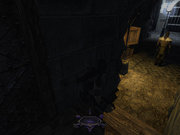
A somewhat more recent genre, sometimes referred to as a "sneaker" to make contrast with the action-oriented "shooter" subgenre. These games have much in common with the first- or third-person shooter types, but tend to emphasize subterfuge and precision strikes over the more overt mayhem of shooters. Examples of the stealth genre include the Thief series, the Metal Gear series, Splinter Cell series, and Beyond Good & Evil.
Survival horror

Survival horror games focus on fear and attempt to scare the player via traditional horror fiction elements such as atmospherics, death, the undead, blood and gore. Many of these games include first-person shooter elements.
The genre is thought to having originated with Alone in the Dark and to a lesser extent System Shock, and was popularized by the Resident Evil series. Other notable games in the genre include Silent Hill and Fatal Frame (Project Zero).
Traditional
Most popular board games, card games, and the like have been computerized to some degree or another. For example, almost 1000 freeware board games are available written in Zillions. Computer game programs can be worthy opponents and can help improve one's skill at traditional games.
- Chess, Checkers, Othello (a.k.a. Reversi), and Backgammon have world class computer programs.
- Mah-jongg and related games are immensely popular in Japan.
- I-go, popular in Asia.
- Magic: The Gathering has had computer versions for some time.
Superseded genres
Adventure

Kings_Quest.png
Adventure games were some of the earliest games on the market. They cast the player as the protagonist of a story, normally requiring the player to solve various puzzles using various artifacts. The earliest adventure games were textual (text adventures or interactive fiction). In these early adventure games, the player uses a keyboard to enter commands such as "get rope" or "go west" and the computer describes what is happening.
As graphics became more common, adventure games began to supplement and later on replace textual descriptions with visuals (for example, a picture of the current location). These graphical adventure games still used textual input.
The growing use of mice led to the 'point-and-click' genre of adventure games, where the player would no longer have to type commands. The player could, for example, click on a hand icon and then on a rope to pick up the rope.
Mass-market adventure games are rare today, and most new entries into the genre are fan-created interactive fiction games.
Adventure games began with Colossal Cave Adventure in the 1970s, later developed into the Zork series, and rose to popularity in the 1980s and early to mid-1990s. Notable titles include Day of the Tentacle, the King's Quest series and the Monkey Island games. The more action-orientated adventure games such as Syberia or Full Throttle, incorporate other modes of gameplay.
Interactive movies
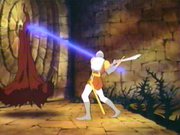
Interactive movies came about with the invention of laserdiscs. These games are pre-filmed full-motion cartoons or live-action sequences, where the player controls some of the moves of the main character. For example, when in danger, the player decides which move or action, or combination to choose. In these games, the only activity the user has is to choose or guess the move the designers intended him to make.
With the evolution of the more flexible 3D graphics, interactive movies are quickly disappearing.
Notable games of this category include Dragon's Lair and Space Ace.
Retro
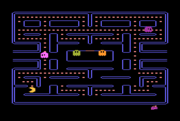
Retro is not necessarily a genre and can refer to any game, even a new one, that adopts a style or "feel" that has since been superseded. However, the term is most commonly used to specifically refer to the early games following a simple (if not simplistic) interface that involves, at most, simple four-directional movement and one basic command. Most pre-Nintendo Entertainment System console and arcade games could be classified as "retro". Pong and Pac-Man are probably the two most notable examples of the genre.


